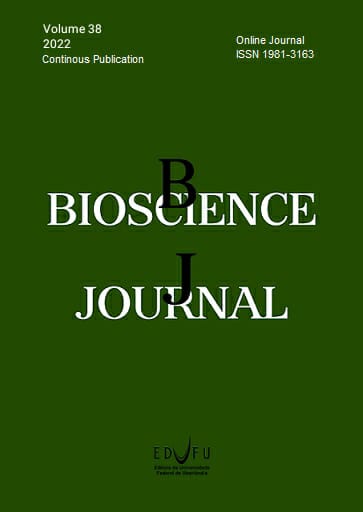Bio prospecting of Riboflavin producing bacteria from different riboflavin enriched food sources
DOI:
https://doi.org/10.14393/BJ-v38n0a2022-62495Keywords:
Bacillus cereus, Citrobacter freundii. , Lactobacillus plantarum, RiboflavinAbstract
Riboflavin is an essential, water-soluble vitamin (B2) and a component of basic cellular metabolism. The aim of the present study is to isolate and characterize riboflavin producing bacteria from different food sources. Ten different riboflavin enriched food sources were collected from Vellore district. Totally 72 bacterial strains were isolated and cultured on nutrient agar plates. Out of these, 43 strains were identified as riboflavin producers. Isolated bacterial strains HDS27, HDS07, HDS14, HDS18, HDS38 and HDS54 isolated from milk, mushroom, spinach, lamb kidney, beef liver and mackerel fish were found to be potent riboflavin producers. Based on morphological, biochemical and molecular characterization, the potent strains were identified as Lactobacillus plantarum (HDS27), Bacillus cereus (HDS07), Delftia tsuruhatensis (HDS14), Citrobacter freundii (HDS18), Enterobacter cloacae (HDS38) and Bacillus cereus (HDS54). The selected potent isolates HDS27 from milk and HDS07 from mushroom showed a maximum riboflavin production of 3.69 mg/L and 2.9mg/L respectively. The present study explores the riboflavin producing novel bacteria from different food sources. This is the first report that the Enterobacter cloacae isolated from beef liver, Delftia tsuruhatensis from spinach and Citrobacter freundii from lamb kidney has the ability to produce riboflavin. These potent strains could be a better starter for substituting the conventional bacteria for large scale production of riboflavin in industry.
References
ALTSCHUL, S.F., et al. Basic local alignment search tool. Journal of molecular biology. 1990, 215(3), 403-410. https://doi.org/10.1016/S0022-2836(05)80360-2
BURGESS, C., et al. Riboflavin production in Lactococcus lactis: potential for in situ production of vitamin-enriched foods. Applied and Environmental Microbiology. 2004, 70(10), 5769-5777. https://doi.org/10.1128/AEM.70.10.5769-5777.2004
CAPOZZI V., et al. Lactic acid bacteria producing B-group vitamins: a great potential for functional cereals products. Applied Microbiology and Biotechnology. 2012, 96, 1383-94. https://doi.org/10.1007/s00253-012-4440-2
CHU, R., et al. Production of vitamin B2 (riboflavin) by Bacillus subtilis. Journal of chemical technology and Biotechnology. 2021, 2021. https://doi.org/10.1002/jctb.7017
EDGAR, R.C. and MUSCLE, A. Multiple sequence alignment with high accuracy and high throughput. Nucleic acids research. 2004, 32(5), 1792-1797. https://doi.org/10.1093/nar/gkh340
EDWARDS, U., et al. Isolation and direct complete nucleotide determination of entire genes: characterization of a gene coding for 16S ribosomal RNA. Nucleic acids research. 1989, 17, 7843–7853. https://doi.org/10.1093/nar/17.19.7843
HAN, J., et al. Characterization of a novel plant growth-promoting bacteria strain Delftia tsuruhatensis HR4 both as a diazotroph and a potential biocontrol agent against various plant pathogens. Systematic and Applied Microbiology. 2005, 28(1), 66-76. https://doi.org/10.1016/j.syapm.2004.09.003
KALINGAN, A.E., KRISHNAN, R.V. Application of agro-industrial by-products for riboflavin production by Eremothecium ashbyii NRRL1363. Applied Microbiology and Biotechnology. 1997, 47,226-230. https://doi.org/10/1007/s002530050917
KATO, T., PARK, E.Y. Expression of alanine: glyoxylate aminotransferase gene from Saccharomyces cerevisiae in an Ashbya gossypii. Applied microbiology and biotechnology. 2006, 71, 46-52. https://doi.org/10.1007/s00253-005-0124-5
KIM, J.Y., et al. Probiotic Potential of a Novel Vitamin B2-Overproducing Lactobacillus plantarum Strain, HY7715, Isolated from Kimchi. Applied Sciences. 2021, 11(13), 5765. https://doi.org/10.3390/app11135765
KRYMCHANTOWSKI, A.V., BIGAL, M.E., and MOREIRA, P.F. New and emerging prophylactic agents for migraine. CNS Drugs. 2002, 16(9), 611-34. https://doi.org/10.2165/00023210-200216090-00003
KUMAR, S., STECHER, G. and TAMURA, K. MEGA7: molecular evolutionary genetics analysis version 7.0 for bigger datasets. Molecular Biology and Evolution. 2016, 33(7), 1870-1874. https://doi.org/10.1093/molbev/msw054
LIU, S., et al. Production of riboflavin and related cofactors by biotechnological processes. Microbial Cell Factories. 2020, 19, 31. https://doi.org/10.1186/s12934-020-01302-7
LIN, J.W., CHAO, Y.F. and WENG, S.F. Riboflavin synthesis genes ribE, ribB, ribH, ribA reside in the lux operon of photobacterium leiognathi. Biochemical and Biophysical Research. 2001, 284, 587- 592. https://doi.org/10.1006/bbrc.2001.5013
ORAEI, M., RAZAVI, S.H. and KHODAIYAN, F. Optimization of effective minerals on riboflavin production by Bacillus subtilis subsp. subtilis ATCC 6051 Using Statistical Designs. Avicenna Journal of Medical Biotechnology. 2018, 10(1), 49-55.
OTTO, R., et al. The relation between growth rate and electrochemical proton gradient of Streptococcus cremoris. FEMS microbiology letters. 1983, 16, 69-74. https://doi.org/10.1111/j.1574-6968.1983.tb00261.x
SAUER, U., et al. Physiology and metabolic fluxes of wild-type and riboflavin-producing Bacillus subtilis. Applied and environmental microbiology. 1996, 62, 3687-3696. https://doi.org/10.1128/aem.62.10.3687-3696.1996
STAHMANN, K.P., et al. Formation and degradation of lipid bodies found in the riboflavin producing fungus Ashbya gossypii. Applied Microbiology and Biotechnology. 1994, 42, 121-127. https://doi.org/10.1007/BF00170234
STAHMANN, K.P., REVUELTA, J.L. and SEULBERGER, H. Three biotechnical processes using Ashbya gossypii, Candida famata, or Bacillus subtilis compete with chemical riboflavin production. Applied Microbiology and Biotechnology. 2000, 53, 509-516. https://doi.org/10.1007/s002530051649
SYBESMA, W., et al. Increased production of folate by metabolic engineering of Lactococcus lactis. Applied and environmental microbiology. 2003, 69, 3069-3076. https://doi.org/10.1128/AEM.69.6.3069-3076.2003
THAKUR, K. and TOMAR, S.K. Exploring Indigenous Lactobacillus Species from Diverse Niches for Riboflavin Production. Journal of Young Pharmacists. 2015, 7(2), 122-127. https://doi.org/10.5530/jyp.2015.2.11
THAKUR, K. and TOMAR, S. Lactic acid bacteria as a cell factory for riboflavin production. Microbial biotechnology. 2016, 9(4), 441-51. https://doi.org/10.1111/1751-7915.12335
VALLE, J.D.M. Riboflavin producing lactic acid bacteria as a biotechnological strategy to obtain bio-enriched soymilk. Food Research International. 2014, 62, 1015-1019.
WANG, X., et al. Enhancement of riboflavin production with Bacillus subtilis by expression and site-directed mutagenesis of zwf and gnd gene from Corynebacterium glutamicum. Bioresource technology. 2011, 102, 3934-3940. https://doi.org/10.1016/j.biortech.2010.11.120
YUNXIA, D., et al. Enhanced riboflavin production by expressing heterologous riboflavin operon from B. cereus ATCC14579 in Bacillus subtilis. Chinese journal of chemical engineering. 2010, 18, 129-136. https://doi.org/10.1016/S1004-9541(08)60333-X
Downloads
Published
Issue
Section
License
Copyright (c) 2022 M Hemalatha, C Subathra Devi

This work is licensed under a Creative Commons Attribution 4.0 International License.





